History of the Capital City of Prague
According to legend, the City of Prague was founded by the wise Princess Libuse, the wife of Přemysl Oráč, the founder of the family, whose beginnings we can only argue. But with absolute precision, we know that his government was maintained in our countries for several hundred years, until August 4, 1306, when Olomouc was the last Přemyslovec after the sword, Václav III.
If we have reports of the beginnings of the history of our capital, they come from the sources of Roman, French or Byzantine sources. Our first worthy chronicler, Kosmas, lived only at the turn of the 11th and 12th centuries.
One of the most respected testimonies dates from 965-96, when he visited Prague as a member of the mission of the Cordoba Caliph-Hakama II. to the emperor Otto I the Arab-Jewish merchant Ibrahim ibn Jacob at-Tartus. His original testimony has not been preserved, but only in a few of the younger writings, but it is generally accepted:
"The city of Fraga is built of stone and lime." We also learn that the city is the center of a large trade where tin, fur, poultry, saddles on horseback, bridles, shields and slaves. They are trading here Russians, Slavs, Muslims, Jews. The goods can be paid with metal coins and fine cloths, which are used especially by the Slavs as a gift.
Since the beginnings of our history, Prague has been the center of all the events that have taken place in this country to our present day. If someone wants to know exactly when Prague was founded, it will find a response in the calendar of Daniel Adam of Veleslavin (1546-1599). It happened on 2 November 723 AD. And if Prague is the capital of Bohemia, it is undoubtedly the capital of Prague Old Town.
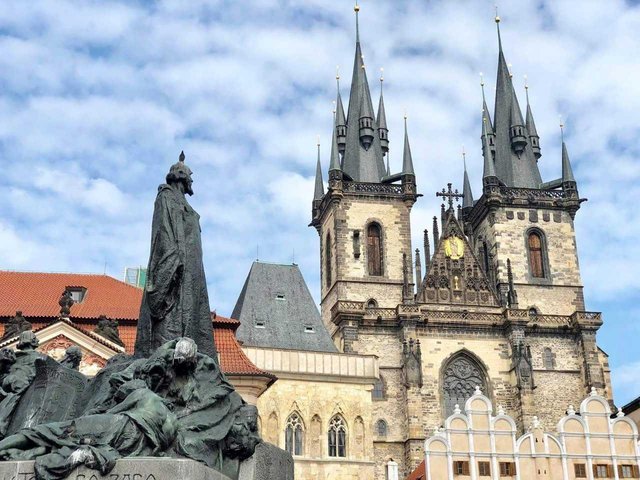
Part of the Old Town was always the Jewish Town - Josefov. From the old Jewish settlement, which existed in the middle of the Old Town on the right bank of the Vltava River, a ghetto was formed and closed, the Jewish Town, the fifth quarter, Josefov.
The Jews also lived in other parts of Prague, on the left bank of the Vltava river, under the castle of Prague, in the places of today's Újezd, in Vysehrad Castle, also in the vicinity of the Sun Garden, a Jewish cemetery in today's Vladislavova Street. Eventually, they concentrated mainly near the Old School and near the Old Synagogue. The Jewish ghetto was formed by the combination of the last two sites. Together with other buildings, the ghetto was connected to the Old Town district of Prague between 1232 and 1234.
Because the Jewish Quarter had its own walls and gates, there was actually a city within the Old Town. After the reforms of Joseph II. it began to honor this emperor, whose governments brought a certain liberation to the Jews, to say to the Jewish Town of Josefov, and in the middle of the 19th century Josefov was involved in Prague as the V. quarter.
After the rehabilitation, which was carried out on the basis of the law of 1893, there was not much left of Joseph. Just a few monuments: the Jewish Town Hall, the Old Jewish Cemetery and several synagogues.
The Kataster Josefova is a line that leads through the streets of Old School, Široka, Pařížská, Jáchymová, Maiselová, Kaprová, November 17, Eliška Krásnohorská, Bílková and Dušní.
In 1784, until now the independent Prague towns of Staré Město, Nové Město, Malá Strana and Hradčany were connected under one city council at the Old Town Hall, Josefov was administratively attached to them from 1850.
It is different from the Old City, which has the right to life resurfacing on the river and which has been preserved despite regular floods. It is given by the terrain, it is safe from floods. Probably this fact, supported by new scientific knowledge, entitles us to claim that here under Prague Castle was probably the oldest settlement. The dispute, I think, will, however, continue to be between the Old Town and the Lesser Towns.
As a town, today's Mala Strana was founded by King Přemysl Otakar II. around the Lesser Town Square sometime in the early spring of 1257. We do not know it exactly here. Earlier there were settlements: Obora, Nebovidy (Nepovidy), Újezd, Rybář, Trávník, but also the fortified enclaves of the Johannites at the Church of the Virgin Mary under the chain, and as an independent fortress, the bishop's court at the stone bridge at today's Dražice Square.
The Lesser Town, originally New Town under the Prague Castle and then the Lesser Town of Prague, was enlarged after the foundation of today's New Town (1348) by new walls for Charles IV. in the years 1360-1362. The Old Town on the right bank of the river was larger, so the town on the left bank was called the Lesser Town of Prague and from the end of the 15th century the Lesser Town.
This quarter fulfills its mission to the Prague Castle. The Old Town has its towers, the Mala Strana, its roofs. On the right bank of the Vltava there are traders, officials and craftsmen, artists, builders and painters on the left bank. And nobility.
The Royal Route goes to the Lesser Town from the Old Town through the stone arch of Charles Bridge, leads through the slightly upward Mostecká Street to Malostranské Square, from which the paths turn as it was in the medieval plan to all sides of the world, rising up Neruda Street to Úvoz and Pohořelci . In these places, the Royal Route rose outside the old walls, out of town, only Charles IV. he built it into the urban organism by building new walls. The archway to the Castle at that time did not yet exist.
The territory of today's Old Town is referred to in some sources as the "Mezigrad", a settlement that may be even older than we suppose to settle outside the prince's residence on the Vltava river between Prague Castle and Vyšehrad. The location of today's Old Town has begun to be shaped by the use of natural terrain along the natural paths of the Vltava River and its tributaries, with which the artificial paths of people, their paths, paths, roads, streets, brody and finally bridges began to cross.
At first, it was a scattered area, buildings made of wood, rare stone churches, courtyards, settlements, and villages, until the settlements were given a solid shape - city walls.
The first Prague city - the Old Town - was created by a combination of scattered and random build-ups, connecting the ethnically diverse population, since there were also foreign settlements alongside Slavic settlements: the Germans in the Poříč or Poříčí village around the church of St. Petra, Romani somewhere between the churches of St. Michal and St. Linhrata and Jewish settlements near today's Old School Street and later around the Old Synagogue.
The only planned part of the Old Town, which is clearly visible on the current maps, became the settlement around the Church of St. Havel, the city of Havel, founded by the locator, the first magistrate and the mintmaster of King Wenceslas I (1230-1250) Eberhard. At the same time, walls were built in the axis of today's streets: Národní - October 28 - On the Ditch - Revolutionary. The castle of the Havel City is five hundred meters long, as the ruler.
Whether the settlements in these places were anyhow old, so old that no one ever finds the beginnings, it is certain that the town is starting to be a town with walls only. It was not only protection but also the privilege, the privilege granted only by the king.
Romulus founded Rome by the founding of the wall, the city of Constantinople begins with the founding of a wall, although the Greek settlement Byzantion existed in the same places.
The Old Town is founded by a wall that begins to build from the river at the same time as the church and the monastery of St. Františka, where she settled in 1234 for the lifetime work of Anežka Česká, the daughter of Přemysl Otakar I and the sister of King Václav I of Svatorecena was in 1989.
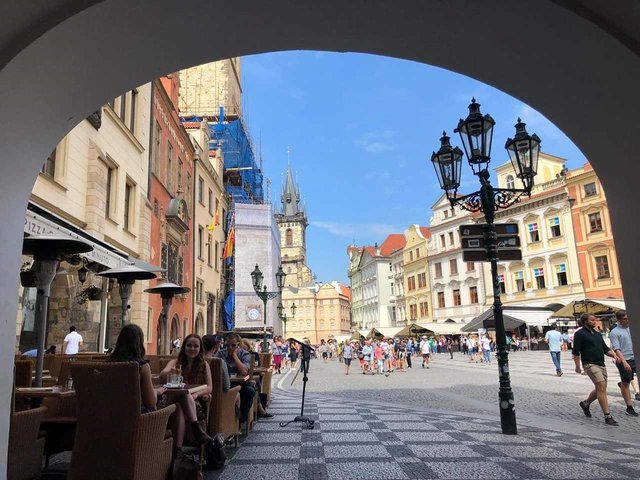
As the water rose in the Vltava River, the moat was filled, and the Old Town became a separate island. However, it has never been isolated. It led the main road from the fords to the island of Štvanice and entered the city today's Long Class. This led the ancient way from Vyšehrad to today's Vyšehradská Street and on the territory of the Old Town by today's Karolina Světlá street, later moved to today's Spálená Street, leading today's Royal Route, which is rather a tourist route from the Republic Square.
We can not imagine a more dignified entrance to the Old Town than the entrance to the Powder Gate, this art sculpture that could be the adornment of every city in the world. But he is too big to move, so for our happiness, pleasure has remained since 1475.
The Royal Route starts at the New and Old Town boundaries with a royal gate and enters Celetna Street, followed by Old Town Square, where the Old Town Astronomical Clock is measured for six hundred years. Here, but also in many other places of Prague, it would be appropriate to quote the Roman historian Tita Livia: Quocunque incedimus ... Everywhere we go, we are going down a trail of history.
The Royal Route continues dignifiedly through Ryneček or Little Square, which is connected with the narrow Charles Street to another beautiful sculpture, to the Old Town Tower. In front of the tower, in the area of Křižovnické Mýlice, which is surrounded by remarkable buildings, we find something that is once again characteristic of Vyšehrad, Petřín, the southern gardens of Prague Castle in Opyše, Letna, Vítkov and hundreds of other places. is the side of the square where nothing is worth. Nothing makes the square meaningful. As if outside, just in the corner of our eyes, we have the Old Town Bridge Tower, the monument of Charles IV, and in front of us the unrepeatable Hradčan panorama - in the frame of the river and the sky.
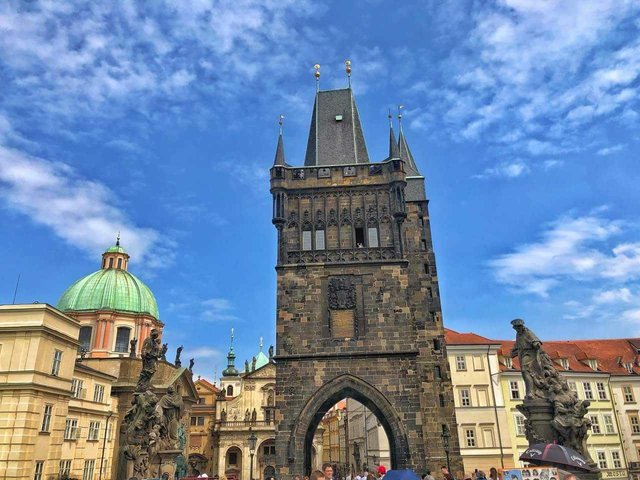
Since its inception it has been inclined to everything new. Nomen Omen! His Town Hall is only a hundred years younger than the Old Town Hall. At this single city in the center of Prague, we know exactly when and how it was created. Preparations for the foundation were made by Charles IV. already in 1347, March 8, 1348, Charles IV. the founding charter of the New Town of Prague and on March 26, 1348, the foundation stone of the New Town was laid. A wall was built from Vyšehrad towards Charles and the river. A new ring of walls was added to Prague's fortresses, which surrounded the Old Town from the Vltava to the Old Town, and newly connected under the protection of the fortifications of Podskalí, Psara, Opatovice, Chudobice, Rybníček, Poříčí, Zderaz and Vyšehrad. Most of this territory is currently under the administration of the Prague 2 district.
If we were to be saddened that the New Town did not lead the Royal Route, which by its route connects as the golden thread of the most important part of the city, we would be mistaken. Even before New Town was founded, the older King's Road led from Vyšehrad to the so-called Vyšehradská cesta, according to the chronicler Kosma in 1091, according to the historian Vilém Lorenz in the 8th century, Vyšehradská Street, an embassy between Emmaus and Dientzenhofer's Church of St. Jana Nepomuckého On the rock, over today's Karlovo náměstí and further to Old Town and its ford and later to the stone bridge.
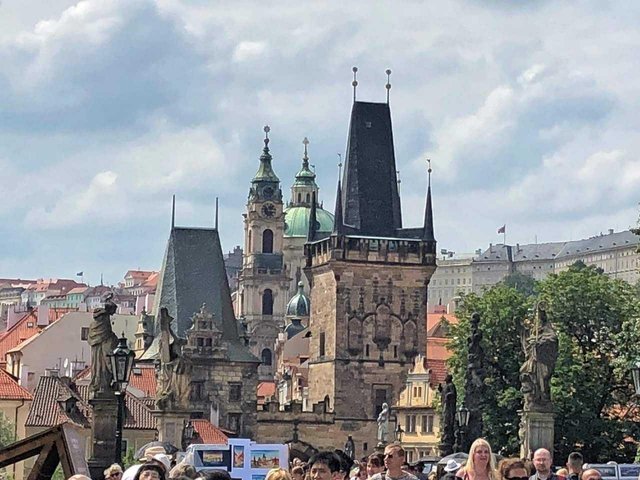
As a town, Hradcany was built from the prehabs sometime around 1320 at the initiative of the highest Burgrave Hynek Berka from Dubé, who represented the rather absent king Jan of Luxembourg. They emerged as the third city on the territory of Prague from the settlement of the inhabitants who lived around the Prague Castle. In fact, it was a solution to the more overcrowded Castle itself.
Hradcany became, over time, a symbol of the city and the state, an exceptional dominant, even though it was a place on a rocky and maybe even then arid, perhaps the name of Prague, the whale ridge or the dolphin, settled in the earliest known historically, Premyslids from the Bohemian tribe from an older settlement on the Left Hradec sometimes in the middle of the 9th century. As a town, Hradčany was born behind Jan Lucemburský, and it was a city of feudalism. Only the Emperor Rudolf II. promoted Hradčany to the royal town in 1598, and only Maria Theresa in 1756 made Hradčan the fourth city of Prague.
Prague Castle is probably one of the few places in Europe or perhaps even in the world, where for more than a thousand years there is a government seat in one place. Even the royal palace, from the lowest and deepest Romanesque space, which still led the road from the hillside to the today's no longer existing South entrance to the Castle, with Gothic and Renaissance superstructures, is still in the same place.
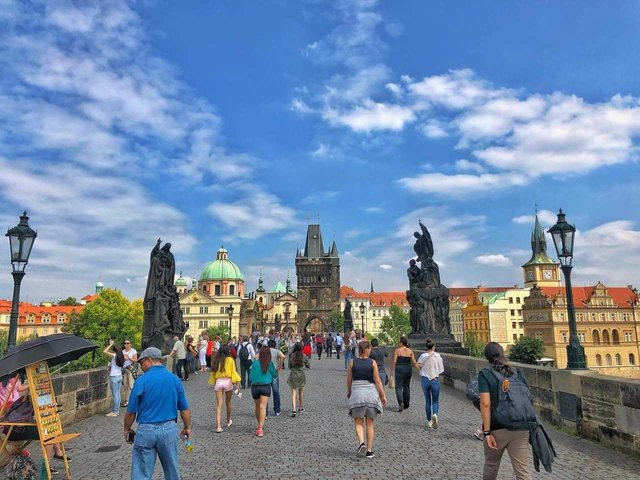
Above the oldest princes and royal halls, the impressive space of the Vladislav Hall is encircled. Presidents Vaclav Havel and Václav Klaus were elected as the last in a number of Czech presidents.
The castle is also exceptional because the power of the secular power was connected here with the Church power almost from the very beginning of the evolving Czech state. Since 973, the castle has been the seat of a bishopric.
By connecting the Poholec for Charles IV. a new precinct was created, so the Royal Route was already fully protected by the city walls. She continued from Pohořelce, followed the Malostranská route, descended through Loretánská Street to dčanské Square and to the gate of Prague Castle where she finished.